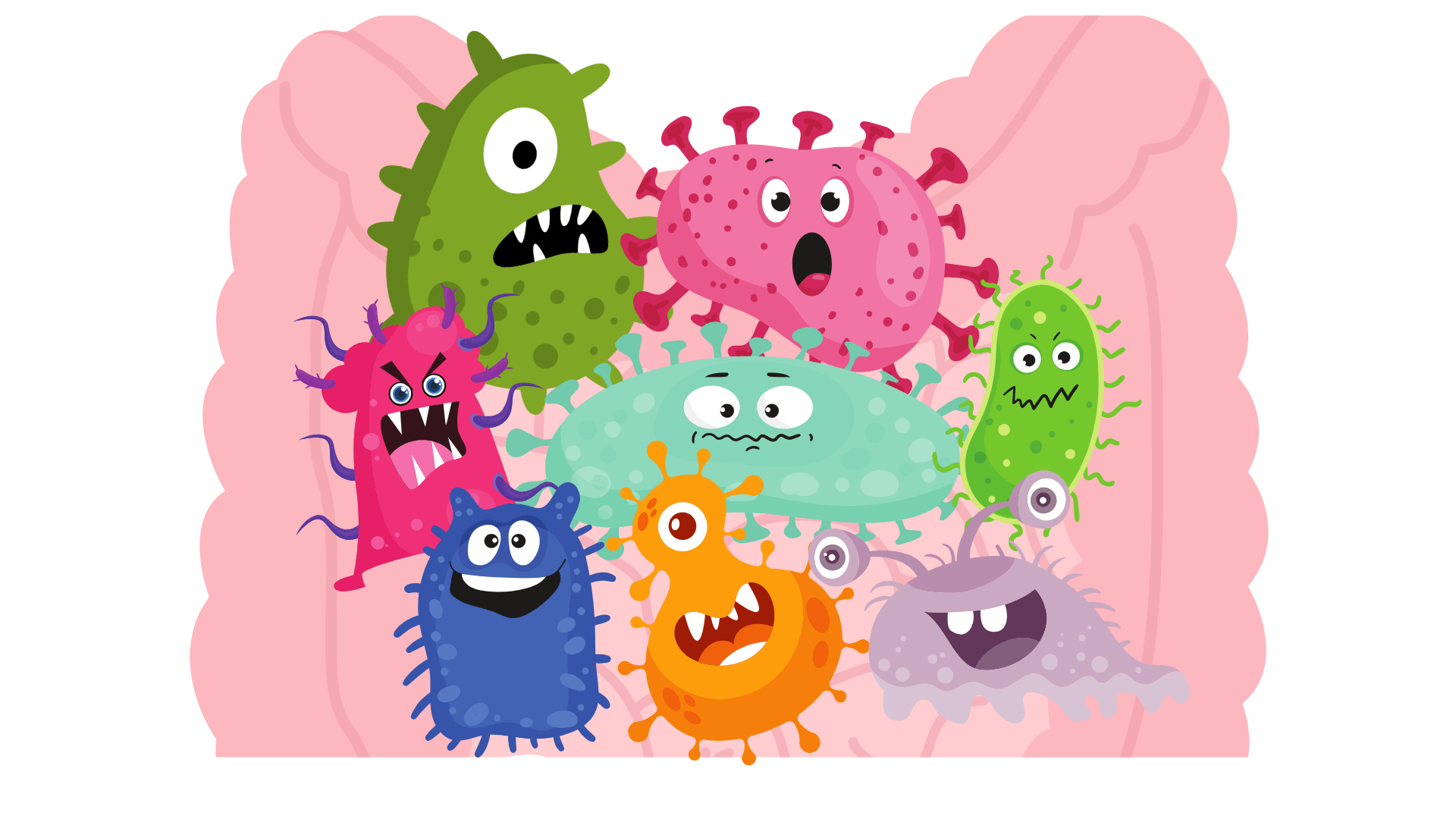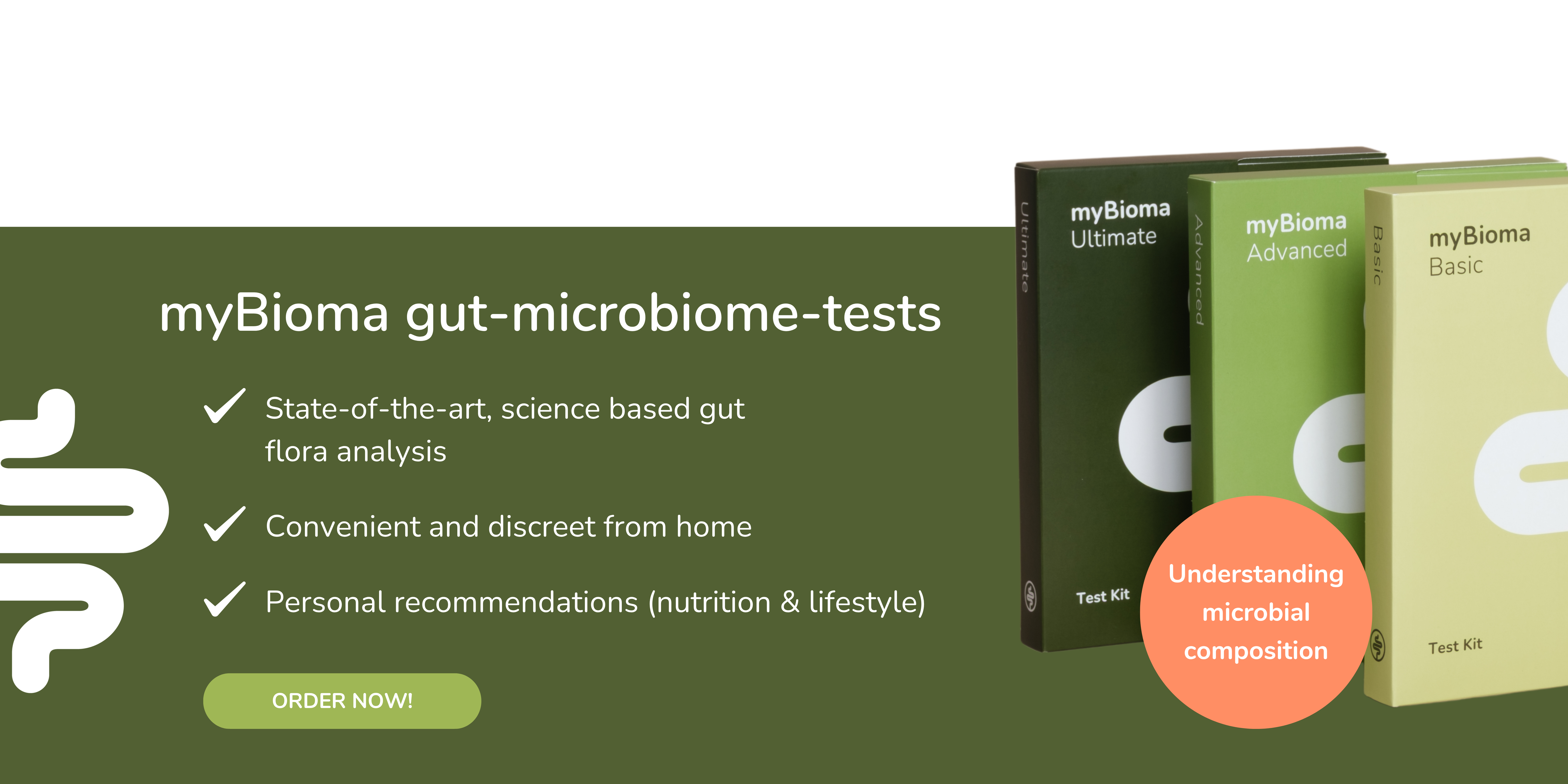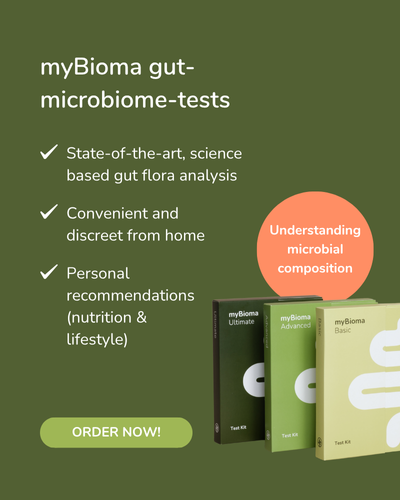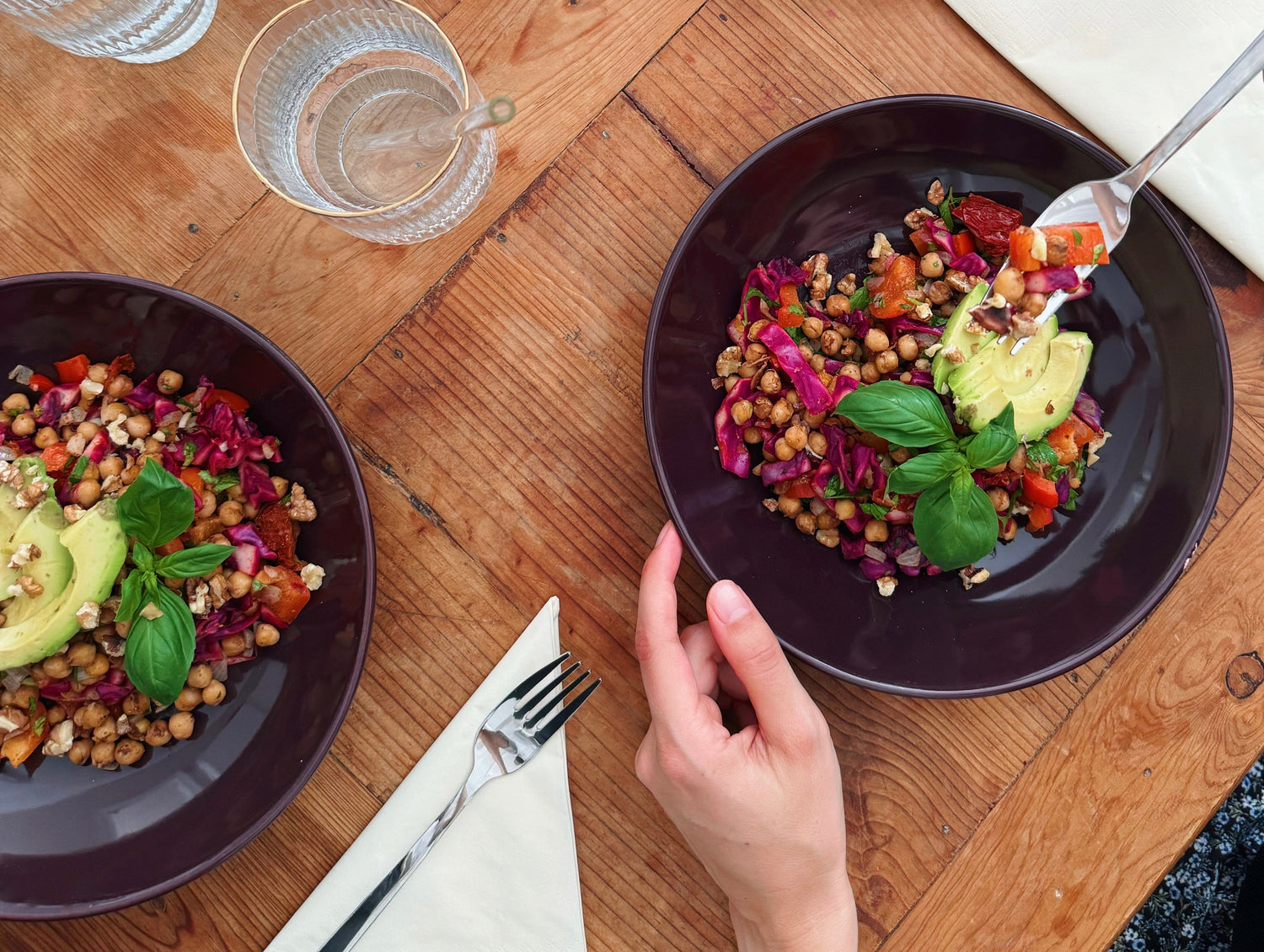Table of contents
- Diversity and dysbiosis: a simple definition
- Environmental factors: How modern lifestyles reduce diversity and can promote dysbiosis
- Recognizing symptoms of dysbiosis and reduced diversity: When your gut is out of sync
- What to do if there is an imbalance in the gut: Tips against dysbiosis and for more microbiome diversity
- Tests: How to measure dysbiosis & diversity
- Microbiome and body weight: influence of diversity and dysbiosis
- Nutrition plan for a diverse microbiome
Your gut is home to a fascinating ecosystem of trillions of microorganisms—the so-called microbiome. It not only supports your digestion but can also influence your immune system, your mood, and even your weight.
What's crucial for health isn't just what lives in the gut, but how diverse this microbiome is. The greater the diversity of the bacterial community, the more stable and resilient your entire organism is. However, when this diversity becomes unbalanced, it's called dysbiosis — an "invisible conflict" in your gut that can have far-reaching consequences: from chronic fatigue and skin problems to an increased risk of depression and many other diseases.
A diverse and balanced intestinal flora (=intestinal microbiome) is not a nice-to-have, but the basis for physical and mental well-being.
Diversity and dysbiosis: a simple definition
Understanding gut diversity
Microbial diversity (alpha diversity) refers to the variety of bacterial species in your gut and is a key indicator for a strong and stable microbiome. It is composed of species richness (how many different species are present) and species evenness (how evenly these species are represented).
A high level of diversity ensures a resilient microbiome that can perform a wide range of tasks: It supports digestion, strengthens the immune system and plays an important role in your mental health.
The importance of diversity can be imagined using the example of a meadow: A meadow with many different plant and insect species is generally more resilient to external influences such as storms, pests, or climate change. Likewise, a species-rich microbiome is more robust and can better protect us from disease. The more different bacterial species there are in the gut, the better nutrients can be utilized, pathogens fought off, and the immune system supported. But it's not just the number of species that matters – their distribution is too. Even if there are 100 different plant species in the meadow, but 90% of the area is dominated by just one plant species, the ecosystem is unbalanced and vulnerable. The situation is similar in the gut: If a single bacterial species takes over, other species that also have important functions to perform are displaced.
When talking about the diversity in the gut microbiome, two important concepts are often distinguished: alpha diversity and beta diversity, although we usually refer to alpha diversity.
Alpha diversity describes the diversity of bacteria within a single sample —that is, how many different bacterial species are present in a person's gut and how evenly they are distributed (1). You can imagine it like looking into your own garden: The more plant species there are and the more balanced they grow, the "healthier" the garden appears. This is exactly what alpha diversity tells you about your gut.
Beta diversity, on the other hand, compares the microbiome composition between two or more samples. It shows how similar or different the microbial communities of different individuals are compared to each other (1). This can be relevant in scientific research for systematically identifying and comparing differences in microbiome composition between different groups – such as between healthy individuals and those with a specific illness. So, here, you don't just look at your own garden, but compare how different or similar it is compared to a neighbor's garden.

Shown here graphically: With alpha diversity, only one sample is analyzed, while with beta diversity, two or more samples are compared.
Imbalance in the intestine: dysbiosis
Dysbiosis is a condition in which the balance of the intestinal flora is disrupted. The microbial balance is often tilted toward microorganisms that can promote inflammation or cause disease. Microbial diversity decreases, and important bodily functions can be impaired.
Factors that can lead to dysbiosis include (2):
- Taking antibiotics
- Low-fibre diet
- Chronic stress
- lack of sleep
- Environmental pollution (e.g. pesticides, microplastics, air pollution)
- Excessive consumption of alcohol or sugar
- Lack of exercise
- Inflammatory bowel diseases
- One-sided diets or long-term fasting
- Food additives (e.g. preservatives, emulsifiers and artificial sweeteners)
Can a good microbial diversity coexist with dysbiosis?
It's entirely possible that the gut microbiome is highly diverse and the bacteria are evenly distributed, but certain – possibly unfavorable – bacteria predominate. In such cases, we speak of dysbiosis, even though microbial diversity itself is within a healthy range and not necessarily reduced. Therefore, it makes sense to consider diversity and dysbiosis as separate parameters and analyze them independently of each other.
Environmental factors: How modern lifestyles reduce diversity and can promote dysbiosis
Our current environment is full of invisible influences that can weaken the microbiome: Air pollution, pesticides, microplastics, and drug residues can reduce the diversity of beneficial gut bacteria. Instead, they promote inflammatory species and disrupt the intestinal barrier—a breeding ground for dysbiosis and chronic conditions. Highly processed foods, sugar, unhealthy fats, and frequent medication use also have negative effects.
What´s particularly striking is that people living in rural areas - who are more in contact with soil, animals and follow a more traditional diet rich in regional, seasonal and unprocessed foods - tend to have a more diverse, stable microbiome than those in urban environments. The Western lifestyle often comes at the expense of our inner diversity (3,4,5).
Recognizing symptoms of dysbiosis and reduced diversity: When your gut is out of sync
Dysbiosis often initially manifests itself through nonspecific symptoms such as bloating, flatulences, abdominal pain, diarrhea and/or mucus in the stool, food intolerances, fatigue, skin problems, or even bad breath. But that's not all - depressive symptoms, anxiety, concentration problems or unexplained weight gain can also be linked to an imbalance in the gut microbiome.
The proliferation of unfavourable bacteria and the simultaneous loss of important species weaken the intestinal barrier and increase systemic inflammation. These processes are now considered to be contributing factors to chronic diseases such as diabetes, cardiovascular disease, and neurocognitive disorders.
The insidious aspect: Because the symptoms are highly varied and often vague, dysbiosis often goes undetected for a long time. In addition, more comprehensive testing of the gut microbiota is rarely carried out in standard medical practice (6).

The symptoms of a disturbed intestinal microbiome are often non-specific and appear in a wide variety of forms.
What to do if there is an imbalance in the gut: Tips against dysbiosis and for more microbiome diversity
A healthy and diverse microbiome is no accident—it can be specifically promoted through our lifestyle. A varied, balanced diet, in particular, provides the necessary diversity of nutrients that your microbiome loves (7,8).
Foods rich in vitamins and secondary plant substances, such as polyphenols, are particularly valuable. These can promote diversity in the gut, create an environment conducive to beneficial bacteria, and help maintain a healthy balance.
💡 These vitamins support your intestinal diversity (9,10):
- Vitamin C: e.g. in (raw and fresh) peppers, citrus fruits, rose hips, broccoli
- Vitamin E and A: e.g. in nuts, seeds, carrots, green leafy vegetables, eggs
- Vitamin B12: in animal products such as milk and dairy products, meat, fish
- Folate: e.g. in spinach, tomatoes, legumes
- Vitamin K , B2 and B3 : e.g. in fish, liver, whole grain products
🌾 Fibre is essential: It's found in whole grain products, fruits, vegetables, legumes, and nuts and serves as food for our gut bacteria. Prebiotic fibre, such as that found in chicory, leeks, onions, asparagus, oats, rye, apples, or acacia fiber, is particularly effective – it specifically promotes the growth of beneficial bacteria (11,12).
🥣 Fermented foods such as yogurt, kefir, kimchi or sauerkraut also provide probiotic microorganisms ( Lactobacillus, Bifidobacterium ) that stabilize the balance in the intestine and keep unwanted bacteria in check (13).
🚫 What harms your microbiome – and how you can counteract it
Some ingredients in processed foods can disrupt the balance of the gut flora. These include added fructose (common in diet products, fruit yogurts, soft drinks, and sausages) and food additives such as preservatives (e.g. in ready meals, packaged baked goods, or sauces). These have been shown to promote the proliferation of harmful gut bacteria and promote inflammatory processes (14,15).
Sweeteners such as aspartame, saccharin, or sucralose are also suspected of promoting dysbiosis. If you don't want to give up sweetness, natural alternatives such as ripe bananas, dates, maple syrup, or yacon syrup are a better choice—they protect the microbiome while providing valuable nutrients (16,17).
🧘 Not to forget: the influence of stress
Chronic stress has a direct impact on your gut. It can promote inflammation, weaken the intestinal barrier, and disrupt the healthy balance of bacteria (18,19). Therefore, it's worth incorporating regular, short breaks into your daily routine: Breathing exercises, walks, yoga, stretching, or even sauna sessions help calm the nervous system—and thus also the gut.
Sometimes just a few conscious breaths are enough to bring body and mind into harmony. If you like, treat yourself to a brief moment just for yourself – without any distractions. Your gut will thank you!
The following breathing exercise only takes a few minutes and can benefit you immediately.
🌬 The 4-7-8 breathing technique to calm the intestinesHere's how:
|
This is how it works: Breathing techniques can help you actively calm your nervous system, reduce acute stress, or even relieve intestinal problems such as bloating or irritable bowel syndrome.

Even with very simple, small exercises or everyday routines you can counteract stress sustainably.
Medical therapeutic approaches for dysbiosis
In some cases, medical therapies may also be necessary to combat dysbiosis and increase diversity in the intestine.
Fecal transplantation (FMT) can be particularly effective for recurrent Clostridioides difficile infections, with cure rates exceeding 90%. If you want to learn more about the use of fecal transplantation, read our article: Fecal Transplantation - A Promising Treatment for Clostridioides
In certain cases, antibiotics or antifungals are also used to reduce unwanted bacteria or fungi. At first glance, this may seem contradictory—after all, antibiotics themselves can promote dysbiosis. However, in some situations, this step is necessary to control excessive or harmful microbial colonization and subsequently restore the gut in a targeted and sustainable manner. Probiotics and prebiotics are also often part of a therapy (2) .
It's important to note that such measures should never be attempted on your own. To restore a balanced, diverse gut microbiome, seek individual advice from a treating physician or nutritionist, receive close support, and work with them to select the appropriate treatment(s) for you.
Tests: How to measure dysbiosis & diversity
Dysbiosis cannot be diagnosed through standard blood tests or imaging techniques. Instead, gut microbiome testing provides a detailed analysis of the microbiome and reveals imbalances in the gut. A stool test measures microbiome diversity and helps identify the presence of harmful or pro-inflammatory bacteria that could indicate dysbiosis (2) .
With our myBioma microbiome test, we can also show you the status of your gut microbiome diversity and whether dysbiosis is suspected. Take a closer look at the gut microbiome test here: myBioma gut microbiome test
The results of the microbiome test provide valuable information about which measures are best suited to bring your microbiome back into balance and promote your intestinal health.
In addition, breath tests can be used to measure the presence of gases such as hydrogen and methane, which can be elevated in cases of disturbed microbiome balance, such as SIBO (Small Intestinal Bacterial Overgrowth) (2). SIBO can be considered a form of dysbiosis, characterized by excessive or misdirected bacterial colonization of the small intestine. Furthermore, SIBO disease can also affect the composition of the microbiome in the colon, leading to alterations there.
Microbiome and body weight: influence of diversity and dysbiosis
Energy balance and weight regulation can be disrupted on several levels by an imbalanced microbiome. Certain bacteria are able to extract more calories from the same amount of food, which promotes fat storage. At the same time, certain bacteria promote inflammatory processes in the body, for example, through the increased production of lipopolysaccharides (LPS). This silent inflammation can contribute to insulin resistance and lead to metabolic disorders.
If you are interested in the topic of inflammation and lipopolysaccharides in more detail, take a look at this article from us: Lipopolysaccharides (LPS) - an underestimated factor for our health?
In addition, our feelings of hunger and satiety are also controlled by our gut microbiome. If they are out of balance, it can disrupt the fine coordination of important hormones such as leptin and ghrelin – which can lead to cravings and uncontrolled eating. A lack of anti-inflammatory short-chain fatty acids such as butyrate, which are normally produced by our intestinal bacteria from fiber, not only does the intestinal barrier suffer – lipid metabolism and the body's ability to cope with inflammation can also be disrupted, making weight regulation more difficult (20).
Nutrition plan for a diverse microbiome
To help you start feeding your gut microbes the right away, we´ve put together a delicious example day featuring gut-friendly, flavourful and diverse meals - all quick an easy to prepare, without spending hours in the kitchen!
| Breakfast |
🥑 Whole-grain bread with avocado & fermented toppings: Mash the avocado, top with some sauerkraut or kimchi and optionally add a fried egg – great for the microbiome. OR for all of us who prefer a sweet breakfast: 🍓 Overnight Oats: Mix oat flakes with (plant-based) milk, chia seeds, some (plant-based) yogurt, berries and nuts in a bowl and leave in the fridge overnight - prepared in the evening, ready to hand in the morning. 🍵 A delicious matcha green tea for your breakfast: for your caffeine kick and secondary plant substances. |
| Lunch |
🥗 Lentil salad with roasted vegetables and feta: Bake carrots, beets, and zucchini in the oven, then crumble some feta cheese on top. Toss the lentils with finely diced tomatoes, cucumber, and optionally onion and fresh herbs, then finish with a vinegar and oil dressing. |
| Snack/Dessert |
🍎 Chocolate date apple: Slice the apple, place the date and a piece of dark chocolate (at least 80% cacao content) on top. Optionally, sprinkle with salt or lemon juice. OR 🥪 Lentil waffles with cream cheese and fresh sprouts or radishes: A protein-rich, refreshing snack. |
| Dinner |
🍲 Rice and vegetable stir-fry with salmon or tempeh: Cook whole-grain rice while sautéing broccoli, bell peppers, and fennel in a little oil. Separately, fry the salmon fillet or tempeh in a pan until crispy and season with soy sauce. Combine everything in a large pan and top with fresh ginger, sesame seeds, spring onions, or cilantro, if desired. |
What makes these delicious dishes stand out: they provide you and your microbes with sufficient nutrients and secondary plant substances, anti-inflammatory omega-3 fatty acids, probiotic foods and fiber.
Keep in mind: Instead of being guided by short-term dietary trends and eliminating many foods from your diet, focus on a plant-based and varied diet that suits you and your lifestyle in the long term – this not only nourishes the beneficial gut bacteria, but also your long-term health.
~~~~~~~~~~~~~~~~~~~~~~~~~~~~~~~~~~~~~~~~~~~~~~~~~~~~~~~~~~~~~~~~~~
As you can see, whether caused by stress, diet, or medication, the balance in the gut is delicate. The good news is that dysbiosis can often be restored to balance with the right knowledge, a little patience, and targeted measures. Even small, daily decisions can rewrite the script for your gut health. With that in mind, listen to your gut and take care of yourself. 🧡
References
- BIOMCARE. (n.d.). Key Terms in Microbiome Analyzes. In Key terms in microbiome projects. https://biomcare.com/info/key-terms-in-microbiome-projects/
- Hrncir, T. (2022). Gut Microbiota Dysbiosis: Triggers, Consequences, Diagnostic and Therapeutic Options. Microorganisms. https://doi.org/10.3390/microorganisms10030578
- Rio, P., Gasbarrini, A., Gambassi, G., & Cianci, R. (2024). Pollutants, microbiota and immune system: Frenemies within the gut. Frontiers in Public Health, Volume 12-2024. https://www.frontiersin.org/journals/public-health/articles/10.3389/fpubh.2024.1285186
- Vich Vila, A., Collij, V., Sanna, S., Sinha, T., Imhann, F., Bourgonje, AR, Mujagic, Z., Jonkers, DMAE, Masclee, AAM, Fu, J., Kurilshikov, A., Wijmenga, C., Zhernakova, A., & Weersma, RK (2020). Impact of commonly used drugs on the composition and metabolic function of the gut microbiota. Nature Communications, 11(1), 362. https://doi.org/10.1038/s41467-019-14177-z
- Vinogradova Elizaveta, Mukhanbetzhanov Nurislam, Nurgaziyev Madiyar, Jarmukhanov Zharkyn, Aipova Rakhilya, Sailybayeva Aliya, Bekbossynova Makhabbat, Kozhakhmetov Samat, & Kushugulova Almagul. (2024). Impact of urbanization on gut microbiome mosaics across geographic and dietary contexts. mSystems, 9(10), e00585-24. https://doi.org/10.1128/msystems.00585-24
- Alagiakrishnan, K., Morgadinho, J., & Halverson, T. (2024). Approach to the diagnosis and management of dysbiosis. Frontiers in Nutrition, 11, 1330903. https://doi.org/10.3389/fnut.2024.1330903
- Choi, Y., Hoops, SL, Thoma, CJ, & Johnson, AJ (2022). A Guide to Dietary Pattern–Microbiome Data Integration. The Journal of Nutrition, 152(5), 1187-1199. https://doi.org/10.1093/jn/nxac033
- Wang, Y., Do, T., Marshall, LJ, & Boesch, C. (2023). Effect of two-week red beetroot juice consumption on modulation of gut microbiota in healthy human volunteers – A pilot study. Food Chemistry, 406, 134989. https://doi.org/10.1016/j.foodchem.2022.134989
- Gubert, C., Kong, G., Renoir, T., & Hannan, A.J. (2020). Exercise, diet and stress as modulators of gut microbiota: Implications for neurodegenerative diseases. Neurobiology of Disease, 134, 104621. https://doi.org/10.1016/j.nbd.2019.104621
- Pham, VT, Dold, S., Rehman, A., Bird, JK, & Steinert, RE (2021). Vitamins, the gut microbiome and gastrointestinal health in humans. Nutrition Research, 95, 35-53. https://doi.org/10.1016/j.nutres.2021.09.001
- Gostimirovic, M., Rajkovic, J., Bukarica, A., Simanovic, J., & Gojkovic-Bukarica, L. (2023). Resveratrol and Gut Microbiota Synergy: Preventive and Therapeutic Effects. International Journal of Molecular Sciences, 24(24), 17573. https://doi.org/10.3390/ijms242417573
- Partula, V., Mondot, S., Torres, MJ, Kesse-Guyot, E., Deschasaux, M., Assmann, K., Latino-Martel, P., Buscail, C., Julia, C., Galan, P., Hercberg, S., Rouilly, V., Thomas, S., Quintana-Murci, L., Albert, ML, Duffy, D., Lantz, O., & Touvier, M. (2019). Associations between usual diet and gut microbiota composition: Results from the Milieu Intérieur cross-sectional study. The American Journal of Clinical Nutrition, 109(5), 1472-1483. https://doi.org/10.1093/ajcn/nqz029
- González‐Orozco, BD, García‐Cano, I., Escobar‐Zepeda, A., Jiménez‐Flores, R., & Álvarez, VB (2023). Metagenomic analysis and antibacterial activity of kefir microorganisms. Journal of Food Science, 88(7), 2933-2949. https://doi.org/10.1111/1750-3841.16614
- Chen, C., Liu, C., Mu, K., & Xue, W. (2024). Lactobacillus paracasei AH2 isolated from Chinese sourdough alleviating gluten‐induced food allergy through modulating gut microbiota and promoting short‐chain fatty acid accumulation in a BALB /c mouse model. Journal of the Science of Food and Agriculture, 104(2), 664-674. https://doi.org/10.1002/jsfa.12957
- Sánchez-Terrón, G., Martínez, R., Ruiz, J., Luna, C., & Estévez, M. (2023). Impact of Sustained Fructose Consumption on Gastrointestinal Function and Health in Wistar Rats: Glycooxidative Stress, Impaired Protein Digestion, and Shifted Fecal Microbiota. Journal of Agricultural and Food Chemistry, 71(43), 16270-16285. https://doi.org/10.1021/acs.jafc.3c04515
- Aguayo-Guerrero, JA, Méndez-García, LA, Solleiro-Villavicencio, H., Viurcos-Sanabria, R., & Escobedo, G. (2024). Sucralose: From Sweet Success to Metabolic Controversies—Unraveling the Global Health Implications of a Pervasive Non-Caloric Artificial Sweetener. Life, 14(3), 323. https://doi.org/10.3390/life14030323
- Chatelan, A., Raeisi-Dehkordi, H., & Salehi-Abargouei, A. (2024). Substituting Low-Calorie Sweetened Beverages for Sugar-Sweetened Beverages to Prevent Obesity and Cardiometabolic Diseases: Still a Good Idea? Current Developments in Nutrition, 8(3), 102105. https://doi.org/10.1016/j.cdnut.2024.102105
- Dalton, A., Mermier, C., & Zuhl, M. (2019). Exercise influence on the microbiome–gut–brain axis. Gut Microbes, 10(5), 555–568. https://doi.org/10.1080/19490976.2018.1562268
- Mitra, S., Dash, R., Nishan, AA, Habiba, SU, & Moon, IS (2023). Brain modulation by the gut microbiota: From disease to therapy. Journal of Advanced Research, 53, 153-173. https://doi.org/10.1016/j.jare.2022.12.001
- Breton, J., Galmiche, M., & Déchelotte, P. (2022). Dysbiotic Gut Bacteria in Obesity: An Overview of the Metabolic Mechanisms and Therapeutic Perspectives of Next-Generation Probiotics. Microorganisms, 10(2), 452. https://doi.org/10.3390/microorganisms10020452







